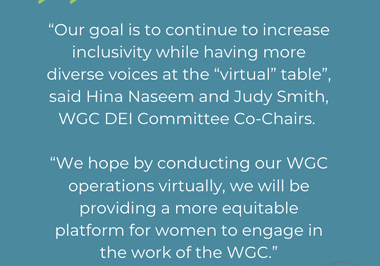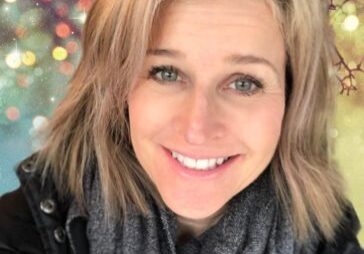STORY BY Gina Gallucci-White PHOTOGRAPHY BY Mary C. Gardella
June/July 2017
Instead of driving a car to work, Jane Dembner takes her bike. It’s a six mile commute to her Columbia-based workplace each way. “It’s a really good way to stay fit,” she says. Commuting by bike may not be the most strenuous of workouts,she says, “But if you add it all up for the week, it’s not bad.”Dembner says she no longer feels the need to go to the gym: “I have gotten my exercise.”
Dembner tries to bike to work as often as she can even when the weather is bad—as long as it’s safe, she says. “You don’t avoid leaving the house when it’s raining,” she says. “You just have an umbrella.” Of course, when she rides her bike in the rain, she uses extra caution, Dembner says.
Marcia Cohen, whose love for cycling was reignited by a noncompetitive riding group in Howard County, completed a 300 mile ride from Miami to Key West in January.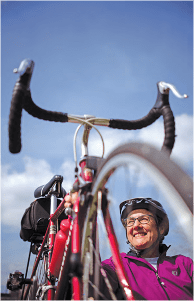
On days when she doesn’t bike to work, one of Dembner’s family members drives her. She doesn’t have to worry about car payments, upkeep or parking fees. Plus she enjoys seeing the world from her bicycle. “You see natural beauty as well as stuff around the community that you don’t see when you are going 50 miles an hour on the roadway,” she points out. And there’s an added bonus: “Who doesn’t like the air going through your hair?”
In April 2016, Howard County adopted its first bicycle master plan. Taking two years to put together using community feedback, the plan aims to identify and develop a countywide system to connect riding routes and bicycle amenities. The projects will be implemented in phases and are funded by the county or through state and federal grants. “Over the next 10 years, we have plenty to work on here,” says Chris Eatough, the county’s bicycle and pedestrian coordinator. Being bike friendly isn’t just to improve residents’ quality of life, says Eatough. It also makes economic sense. “People are interested in living and working in places that are bike and walk friendly,” he points out. The active lifestyle asso¬ciated with bike-friendly regions, he says, “makes the area more attractive for businesses and residents.”
Last year, residents saw the opening of the Downtown Columbia Trail—a 3.1 mile, 10-foot-wide pathway that starts at Howard County General Hospital and ends in Blandair Park. Eventually, that pathway will connect to other trails, so that more people can reach it by bike or on foot, says Eatough. “Connections off the downtown Columbia trail are a current focus.”
Officials are also looking at a bike project in the southeast portion of the county. North Laurel Connections will link Savage Park to the Laurel MARC train station. Eatough says some planning studies have been completed for the project. He projects that construc-tion and implementation will begin in the next year or so.
Just in time for summer, the county planned to launch a Columbia bike share program in late May. Stations at seven locations throughout the down¬town and Oakland Mills area will offer 70 bikes to residents for a small fee. Modeled after programs in Washington, D.C., and New York, the program allows users to pick up a bike at one location and drop it off at another.
Eatough says he hopes the bike share program will appeal to a range of people who might normally be intimidated by riding a bike. To entice those who might be physically challenged or need a boost, some of the shared bikes will offer an electrical assist. “It’s like having a tail wind or somebody giving you a little push up the hill,” Eatough says. “We’re hoping to reach a lot of people and give them an alternative way of getting around in downtown Columbia.”
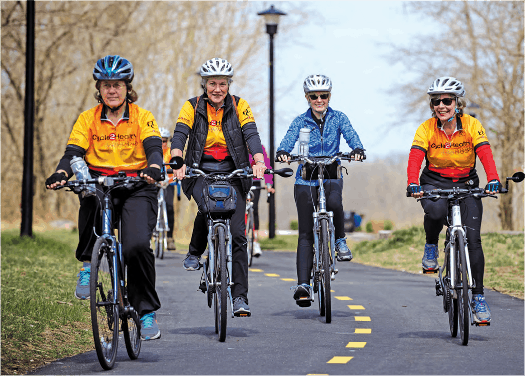 Laurel resident Erica Roberts says she appreciates the county’s bike-friendliness. “It’s nice to know that cyclists are being considered,” she says. Attention to cyclists also makes her feel safer. The designated bike lanes, she says, make both cyclists and drivers more aware of the need to share the road. Cyclists, she points out, “are more visible.”
Laurel resident Erica Roberts says she appreciates the county’s bike-friendliness. “It’s nice to know that cyclists are being considered,” she says. Attention to cyclists also makes her feel safer. The designated bike lanes, she says, make both cyclists and drivers more aware of the need to share the road. Cyclists, she points out, “are more visible.”
Roberts bikes twice a week—often with friends—on the Columbia Gateway Circle and the Iron Girl trail. She enjoys the camaraderie of cycling and has found friends who help to encourage, and often push, each other on the trails. In addition, the regular exercise routine has helped her with toning and endurance.
In January, Columbia resident Marcia Cohen completed a 300-mile bicycle trip from Miami to Key West and back. She attributes her success on the grueling ride to the Howard County program Cycle2Health.
Cohen joined the noncompetitive, peer-led bicycling club three years ago to get back into bicycling. “I once bicycled a lot and then it dropped off. I wanted to get back into the habit,” she says.
Cycle2Health offers group rides with three different levels: casual, moderate and advanced. The rides, offered during daylight hours during the week, are designed for retired residents, says Courtney Barkley, manager of the Health and Wellness division of the Howard County Office on Aging and Independence. “We’re always looking for creative and new programming ideas,” says Barkley. A few years ago, her office was “trying to think outside of the box to attract those who are either newly retired or those who are retired who are not accessing our office.”
Adults of all ages are welcome on the rides. Participants have ranged in age from 40 to 90, Barkley says. Launched in 2013, Cycle2Health is an alternative to cycling groups that offer evening and weekend rides. The program, says Jeannie DeCray, a Cycle2Health exercise specialist, provides a social outlet around a healthy activity. “Cycling can be a solo activity but riding in a club like this gives people a chance to be together,” she says. Furthermore, the program is part of an approach to overall wellness. “Our goal is to enrich people’s lives not just on a physical level, but in the social and emotional components of their lives,” DeCray points out.
Marcia Cohen usually rides with Cycle2Health’s moderate level riders. She didn’t know anyone in the group when she first registered, but has since expanded her circle of friends. “I enjoy seeing them on the regularly scheduled rides,” she says. Regular riding companions helps Cohen to get out for regular rides. “You know those mornings when you get up and say ‘Oh. I should but I don’t want to’?” she askes. With Cycle2Health, her inner monologue is more like, “’I should. Yeah. I’d like to’.”*
SASSY LOCAL JERSEYS
Sassy Cyclist jerseys are designed for comfort—and without loud logos.
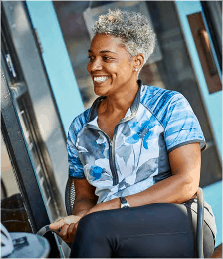
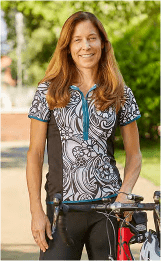 Becky Redett and her friends always complained about cycling jerseys. The fit. The material. The logos printed all over them. “You don’t want to be looking like you are heading for the Tour de France in your neighborhood,” Redett says. “A lot of women just aren’t into that.”
Becky Redett and her friends always complained about cycling jerseys. The fit. The material. The logos printed all over them. “You don’t want to be looking like you are heading for the Tour de France in your neighborhood,” Redett says. “A lot of women just aren’t into that.”
So the Baltimore resident decided to design her own jerseys. She began research and product development for Sassy Cyclist, named for her cycling group, the Sassy Sisters, In 2014, and started selling her goods in October of the following year. Sassy Cyclist’s quick dry, performance fabric jerseys are longer in the back so riders stay covered while leaning forward on bikes. They feature low pockets so items are easy to reach and a reflective stripe down the back to enhance visibility. And instead of logos, the fabrics are floral, folkloric and geometric. Sassy Cyclist also sells headbands and socks, all manufactured at a Baltimore-based plant. Redett says she is pleased to support a local company. “I feel like I am giving a little bit back to the community by making the product here,” she says.
Reditt, who left her career as a nurse practitioner to start the company, says she is enjoying her new career. “It’s a huge learning curve but it’s fun,” she says. “And it’s been working.”
Sassy Cyclist products are available on the company’s website, sassycyclist.com, and are sold locally at such bicycle events as the Columbia Iron Girl Triathlon and Open Streets HoCo.


